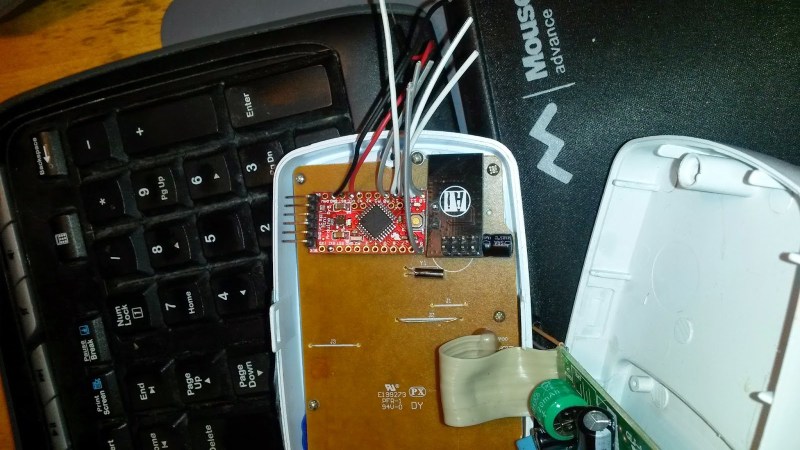[Kalle] is at it again with more hacks on electricity use meters. This time, the meter has been hacked to stream their data over the aether wirelessly. Now, data can be grabbed from multiple devices simultaneously, making the possibilities for home energy monitoring limitless
The first project [Kalle] did involved finding a meter from China with capabilities similar to (and cheaper than) the Kill-a-Watt meters. Unlike the Kill-a-Watt which spits out analog values, the Chinese meter sent digital information out on a ribbon cable with the bus lines labeled. Since the meter was so hackable, [Kalle] took it even further in this hack.
With those pesky wires out of the way, the device now uses an Arduino Pro Mini to sniff the energy meter’s data stream. Then it transmits the data wirelessly with a nRF34L01+ transceiver. As a perk, all of these chips fit inside the case of the energy meter, making this a very tidy hack indeed. The project code an incredible amount of detail is available on the project site, so be sure to check this one out for all of your energy monitoring needs!
















Did you mean nRF24L01? IMHO there is no transceiver named nRF34L01.
You are correct. The source site incorrectly listed the part but it was corrected sometime after the last caching of the site
Quick comment on the USB-serial adapter used – It looks like a CP2102-based eBay cheapie – put a header in the socket to the left of the USB connector (looking from the top) and stick the reset line on the pin nearest the USB connector (DTR). That’ll keep the Arduino happy, and do the resetting for you.
nRF24L01+, not nRF34L01+
Agreed.
Disagreed.
Now this deserves an ESP8266.
He mentions this on the website…. “Connect a .3.3 uF to 10 uF (MicroFarad) capacitor directly on the module from +3.3V to Gnd (Watch + and – !) [Some users say 10 uF or more..]”
I have never found such a need, even for the PA version of the modules. I have, however used 100n across the supply pins on the board holding the module, which i find normal practice. It may be that the 10u is much worse at compensating the module since it is an electrolytic cap with higher impedance. Anyone has more experience with this?
Mine works fine with no cap, just the nrf module directly wired to the 3.3v pro mini arduino clone. I get some weird values come thru sometime after it has been running, I think the battery ran flat as my arduino micro has an LED on it which is probably taking more current than the microcontroller itself, the digits on the meter started to get all washed out and it turned off pretty much as soon as I unplugged it and was barely responsive to the buttons.
Might have to see if I can increase the charge current the battery gets and pull the LED off the arduino clone